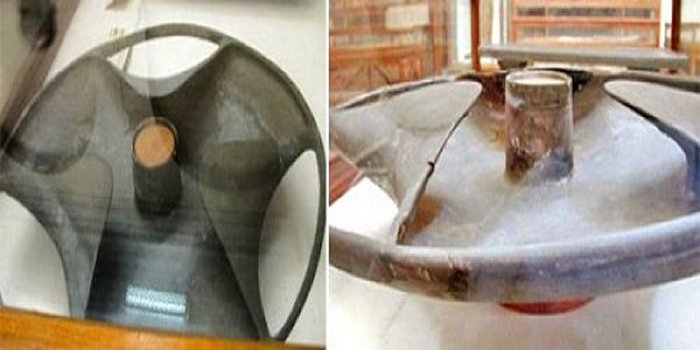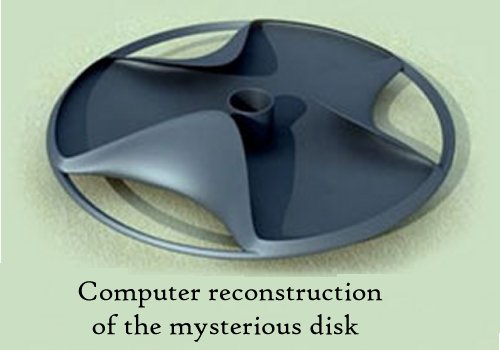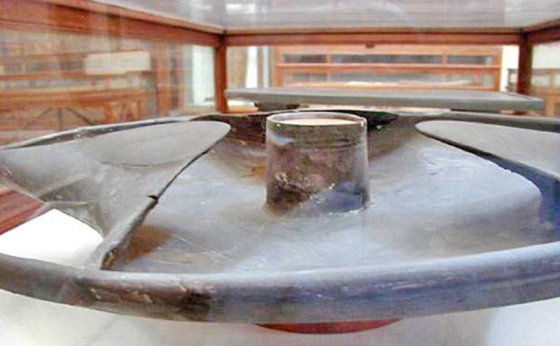Schist Disk – Mysterious Piece Of Sophisticated Technology Could Rewrite History – Scientists Are Not Sure What They Are Dealing With
A. Sutherland - AncientPages.com - Researchers are still not sure what kind of extraordinary object they are dealing with.
This peculiar object created 5,000 years ago appears to be part of a component of an ancient unknown advanced mechanism. In January 1936, a strange disk was unearthed at the plateau edge of North Saqqara, approximately 1.7 km north of Djoser's Step Pyramid in Egypt.
The mysterious prehistoric artifact that many considered a device was made in the Tomb of Prince Sabu ('Mastaba of Sabu' - c. 3100-3000 BC) by a famous British Egyptologist Walter Bryan Emery (1902-1971).
Sabu was the son of Pharaoh Aneddzhiba (fifth ruler of the First Dynasty of ancient Egypt) and a high official or administrator of a town or province possibly called the "Star of the family of Horus."
The burial chamber had no stairway, and its superstructure was completely filled with sand and stone vessels, flint knives, arrows, a few copper tools, and the most interesting schist bowl in fragments.
The Schist Disk's unearthed device is approximately 61 cm in diameter (24 inches), one cm thick, and 10.6 cm (4.2 inches) in the center.
It was manufactured by unknown means from this very fragile and delicate material requiring very tedious carving--the production would confound many craftsmen even today.
Now many important questions arise.
What was the original function of the device?
Scientists do not think the object is a wheel because the wheel appeared in Egypt in 1500 BC, during the 18th Dynasty.
If the Schist Disk is a wheel, it would mean ancient Egyptians possessed knowledge of the wheel about 3000 BC during the time of the first Dynasty! This would require Egyptologists to re-write some history books.
If the Schist Disk is not a wheel nor modeled after the wheel, what is it?
Some scientists suggest that the fragile nature of such an intricately carved stone object significantly limits practical usage and suggests a purely ornamental function, religious or other such ritualistic purposes.
Of course, some believe that this subject served another purpose, just to be able to drive a foot oil lamp.
However, critics of this theory argue that the three-blade ceremonial lamp is hardly possible because of the shape and curvature of its petals, which seems to suggest a function, not just decoration.
Did ancient Egyptians have technology far beyond the current?
One option is even more challenging, namely that we are dealing with some kind of unknown advanced ancient technology. Is it possible ancient Egyptians had technology far beyond the current?
Egyptologist Cyril Aldred concluded that, independently of what the object was used for or what it represented, its design was, without a doubt, a copy of a previous, much older metallic object.
Why did the ancient Egyptians bother to design an object with such a complex structure more than 5,000 years ago?
How could a culture that typically used chisels to shape rock have mastered a technique to work such a delicate material to this extraordinary level?
Why would ancient Egyptians invest the time and skills needed to create this object unless it served a very important, specific purpose?
The Schist Disk's futuristic design continues to baffle all who have seen it. Egyptologists offer several theories trying to explain what the disc was used for, but for the moment, no-one has been able to explain the object's complex structure. Obviously, the Schist Disk is an object that played an important role 5,000 years ago.
Undoubtedly, this peculiar object constitutes one of the most perplexing Egyptian and ancient mysteries, and we are left with several unanswered questions.
The Schist Disk is currently in the Cairo Museum.
Written by – A. Sutherland - AncientPages.com Senior Staff Writer
Updated on August 8, 2021
Copyright © AncientPages.com. All rights reserved. This material may not be published, broadcast, rewritten or redistributed in whole or part without the express written permission of AncientPages.com
More From Ancient Pages
-
 How Greenland Got The ‘Wrong’ Name Thanks To Viking Erik The Red
Ancient History Facts | Mar 21, 2017
How Greenland Got The ‘Wrong’ Name Thanks To Viking Erik The Red
Ancient History Facts | Mar 21, 2017 -
 Hypnos: God Of Sleep Who Owns Much Of Our Lives In Greek Mythology
Featured Stories | Mar 22, 2021
Hypnos: God Of Sleep Who Owns Much Of Our Lives In Greek Mythology
Featured Stories | Mar 22, 2021 -
 Ancient DNA Pushes Herring Trade Back To The Viking Age
Archaeology | Oct 26, 2022
Ancient DNA Pushes Herring Trade Back To The Viking Age
Archaeology | Oct 26, 2022 -
 Riddle Of Mystery Hill: Who Built America’s Stonehenge?
Featured Stories | May 10, 2020
Riddle Of Mystery Hill: Who Built America’s Stonehenge?
Featured Stories | May 10, 2020 -
 On This Day In History: Battle Of Visby, Gotland Was Fought – On July 27, 1361
News | Jul 27, 2016
On This Day In History: Battle Of Visby, Gotland Was Fought – On July 27, 1361
News | Jul 27, 2016 -
 Ostrich Eggshell Beads Reveal 50,000-Year-Old Social Network Across Africa
Archaeology | Dec 21, 2021
Ostrich Eggshell Beads Reveal 50,000-Year-Old Social Network Across Africa
Archaeology | Dec 21, 2021 -
 Unknown Ancient Structures Discovered At Machu Picchu By LIDAR
Archaeology | Mar 29, 2022
Unknown Ancient Structures Discovered At Machu Picchu By LIDAR
Archaeology | Mar 29, 2022 -
 LIDAR Reveals Secrets Of The Enormous Ancient Maya City Of Calakmul
Archaeology | Oct 31, 2022
LIDAR Reveals Secrets Of The Enormous Ancient Maya City Of Calakmul
Archaeology | Oct 31, 2022 -
 Child Finds Impressive 1,800-Year-Old Ring Engraved With Goddess Minerva On Mount Carmel, Israel
Archaeology | Jul 17, 2024
Child Finds Impressive 1,800-Year-Old Ring Engraved With Goddess Minerva On Mount Carmel, Israel
Archaeology | Jul 17, 2024 -
 Why Did Vikings Burn And Bury Their Longhouses?
Ancient Traditions And Customs | May 3, 2017
Why Did Vikings Burn And Bury Their Longhouses?
Ancient Traditions And Customs | May 3, 2017 -
 3,000-Year-Old City Of Sillyon That Alexander The Great Failed To Conquer
Archaeology | Aug 31, 2020
3,000-Year-Old City Of Sillyon That Alexander The Great Failed To Conquer
Archaeology | Aug 31, 2020 -
 Major Earthquake Struck The Atacama Desert 3,800 Years Ago, Forcing Hunter-Gatherers To Move Inland
Archaeology | Apr 7, 2022
Major Earthquake Struck The Atacama Desert 3,800 Years Ago, Forcing Hunter-Gatherers To Move Inland
Archaeology | Apr 7, 2022 -
 Ekambareswarar Temple In Tamil Nadu, India Dedicated To Lord Shiva
Featured Stories | May 10, 2021
Ekambareswarar Temple In Tamil Nadu, India Dedicated To Lord Shiva
Featured Stories | May 10, 2021 -
 A Well-Preserved Lararium Shrine Discovered At Pompeii
Archaeology | Oct 10, 2018
A Well-Preserved Lararium Shrine Discovered At Pompeii
Archaeology | Oct 10, 2018 -
 Dismantled Ancient Stone Circle In West Wales Was Used To Rebuilt As Stonehenge
Archaeology | Feb 13, 2021
Dismantled Ancient Stone Circle In West Wales Was Used To Rebuilt As Stonehenge
Archaeology | Feb 13, 2021 -
 Mystery Of Great Wall Of California: An Ancient Unsolved Enigma
Featured Stories | Oct 28, 2015
Mystery Of Great Wall Of California: An Ancient Unsolved Enigma
Featured Stories | Oct 28, 2015 -
 Shinobi No Mono: The Shadow Warriors And Hattori ‘The Demon’ Hanzo Of Ancient Japan
Featured Stories | Apr 8, 2016
Shinobi No Mono: The Shadow Warriors And Hattori ‘The Demon’ Hanzo Of Ancient Japan
Featured Stories | Apr 8, 2016 -
 Major Puzzle In Mammal Skull Shape Evolution Solved
Evolution | Dec 20, 2023
Major Puzzle In Mammal Skull Shape Evolution Solved
Evolution | Dec 20, 2023 -
 Draugr – Vikings Feared This Ugly Living Dead With Prophetic Visions
Featured Stories | May 24, 2020
Draugr – Vikings Feared This Ugly Living Dead With Prophetic Visions
Featured Stories | May 24, 2020 -
 Evidence Of Copper Processing Unearthed At Archaeological Site In Oman
Archaeology | Mar 6, 2024
Evidence Of Copper Processing Unearthed At Archaeological Site In Oman
Archaeology | Mar 6, 2024




